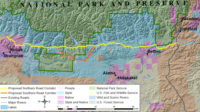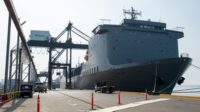Cost and market outlook for a proposed 800-mi liquefied natural gas pipeline and processing complex in Alaska appear more promising, according to a new economic analysis, which also cites a potential boost from the just-enacted federal Infrastructure Investment and Jobs Act.
Energy market research firm Wood Mackenzie, working for the Alaska Gasline Development Corp., lowered its estimated cost for the Alaska LNG project from $45 billion to $38.7 billion, citing a reduction in expected construction costs, projected rise in global LNG demand and a new finance plan with 70% debt financing and third-party tolling.
An 80% federal loan guarantee allowed by the infrastructure act, worth about $26 billion, would help de-risk the project, the analysis notes.
The research firm now has lowered the project’s estimated cost supply to Asia to $6.70/MMBtu, down about 43% from the $11.70/MMBtu cost supply it projected in its previous 2016 analysis. That lower figure to deliver a market-rate return would make gas from the project competitive in Asian markets with LNG from the Gulf of Mexico, according to Wood Mackenzie.
Alaska Gasline Development is the state public corporation tasked to pursue development of Alaska’s North Slope natural gas. The Alaska LNG plan calls for construction of a $9.2-billion gas treatment plant in the North Slope region, an 800-mile pipeline for $12.7 billion and a $16.8-billion liquefaction facility in Nikiski, southwest of Anchorage, to condense gas for transport. State officials say design and construction of the project could support 10,000 jobs.
The 42-in. dia pipeline would have a 3.3-billion-cu-ft daily capacity to move gas from Prudhoe Bay and Point Thomson, the state company says. ExxonMobil, Hilcorp Energy and ConocoPhillips have stakes in the area’s gas supply.
Alaska officials have long sought to develop a North Slope natural gas pipeline. Alaska Gasline Development took over the effort in 2010.
“We are closer now, more than ever, to realizing the decades-old dream of bringing our natural gas off the North Slope for the benefit of Alaskans and worldwide markets,” Alaska Gov. Mike Dunleavy (R) said in a statement.
The project was approved in 2020 by the Federal Energy Regulatory Commission, with its environmental impact statement adopted also by the US Energy Dept., with those approveal challenged by environmental groups in the federal apeals court in Washington, DC.
DOE now has a supplemental environmental review underway to calculate the project's expected greenhouse gas emissions impact.






Post a comment to this article
Report Abusive Comment